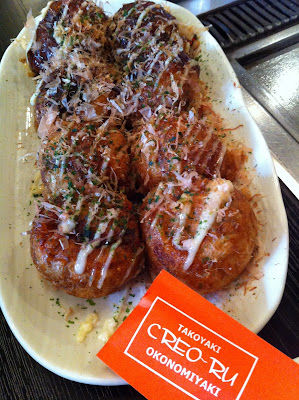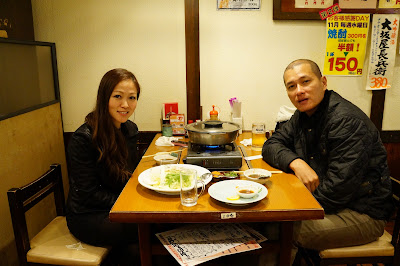Took a non-rapid train, on JR Nara Line, to Inari Station, which is only two stops away from Kyoto.
Fushimi Inari Shrine
Once we got out from the Inari Station, we could see Fushimi Inari Shrine immediately.
The Fushimi Inari Shrine tucks at the foot of Mount Inari which is 233 metres above sea-level, with trails lined with vermillion torii gates up the mountain to many smaller shrines. Inari is the God of rice, seen as the patron of business. The entrance to an Inari shrine is marked by one or more vermilion torii and statues of kitsune (fox messengers). Merchants and businessmen worship Inari for wealth and many vermillion torii gates were donated, which is quite a surreal yet amazing view. No entrance fee needed for entering the shrine.
A big torii gate just before entering the shrine.
As usual, one needs to cleanse themselves (hands and mouths) before praying ritual in a shrine.
The foxes (kitsune), regarded as the messengers of the God, could be found around the shrine.
Visitors can purcase and write down their wishes on the small wooden torii plaques, praying for offsprings, luck in business, a promotion or excel in examination. However praying for money or wealth is considered disrespectful and selfish!


Emu or ema, which is a wooden plaques where people write down their wishes and leave it in the shrine, praying for luck and prosperity.
The little cute fox charms, sold in the shrine.
The starting point where thousands of vermillion torii gates line the path up to Mount Inari.
Names and dates were carved on each donated torii gates.
Foxy-imaged wishing plaques hoping for good luck.
Ema are purchased at the shrine to bring good luck and ward off evil spirits. They have a blank side where visitors can write a wish or request on.
Take a breather after a long walk up the mountain trails.
The donation range depends on the torii gates size which you prefer to buy. The biggest torii gate costs 1,302,000 yen which is about SGD16255 ! Anyone yearns for a better change of luck?

Smaller torii gates with lower budget, for donation.
Can you spot hubby from far? Hahaaaaa.....
After about 45 minutes ascending the mountain trail, we noted a gradual decrease of torii gates density, where eventually ended at the Yotsutsuji intersection which is half way up the mountain. You can admire the scenic views of Kyoto from afar. Many hikers normally will stop at this point and descend back to the bottom, as the trails do not offer much variation beyond this point.
These dogs came hiking with their masters. They were strong and huge, and very obedient. See they posed when their master instructed them to 'SIT' and 'BEHAVE'...LOL
On the day of my visit was actually Sichi-go-san, a day when prayers are made for healthy growth of young children. Sichi-go-san literally means, seven, five, and three...which means both girls and boys aged three, boys aged five and girls aged seven, will visit shrines.
After the visit, we wandered a bit.
There were rows of shops selling.....
Foxy charms...
Tanuki, a fox like dog ceramic statue, sold widely in Japan as souvenirs. This ceramic ornaments is normally displayed in front of bars and restaurants as symbol of luck and wealth.
My favourite kitty charms, disguised in foxy get-up.
Went into a random noodle shop to have a brekkie fix.
Had Nishin soba which is a popular noodle dish in Kyoto. Soba is buckwheat noodle, can be eaten cold or in hot dashi (fish broth) soup served with boiled or grilled herring.
Walked back to Inari Station.
At the train waiting platform, heading back to Kyoto.
Osaka
Once we reached Kyoto, we took off again on a shinkansen (bullet train), Nozomi, heading to Shin Osaka. We departed from Kyoto at 11.45 a.m. The journey only took 12-15 minutes.
This is how the seats in a shinkansen look like. Spacious cabin with plenty leg space.
When we arrived at Shin Osaka, the first thing we did is to get one way ticket from Shin Osaka station to Namba Station on Midosuji Line, cost 270 yen.
Immerse yourself in many local delights. One of the must tries is the takoyaki, which is first popularized in Osaka.
A shop with a gigantic octopus with people queuing for its famous takoyaki, where we got ours.
Takoyaki is a ball-shaped Japanese snack made of wheat flour-based batter and cooked in a metal pan. It is most typically filled with diced octopus (tako), although there are some other fillings available like ham, egg, green onion, etc. Just before it is served, takoyaki will be brushed with special sweet savoury sauce, and squeeze of mayonnaise. Lastly, it is then sprinkled with green laver or chopped seaweed (aonori) and shavings of dried bonito (katsuobushi).
The process of making takoyaki.
This picture below, 8 takoyaki balls cost 520 yen, which is only SGD6.50. It is a recommended must-eat local snack in Osaka, cheap and delicious!
We found Gyu-Kaku in Osaka, my favourite place for a decent BBQ wagyu beef.
Basically, we endured a foodie marathon in Osaka, gorging and stuffing ourselves with food.....Hahaaaa
Stepped into Creo-Ru, where many were seen lining up for its famous takoyaki and okonomiyaki. We had second-helping of takoyaki :D
Ordered the most popular Deluxe okonomiyaki, with everything in one, pork, squid, octopus, shrimp, and scallops, cost 1260 yen, roughly SGD15.80. One tip to share, if you are not too sure with what to order, just look out for the icon, in this case, a crown, showing it is the most well-received by patrons.
Picture below is the deluxe okonomiyaki, which was served and we were allowed to cook it and eat the way we prefered. Okonomiyaki is a Japanese savoury pancake or Japanese pizza with various ingredients. The name is derived from the word okonomi, means what you like or want, and yaki means grilled. Toppings vary according to region.
An okonomiyaki and a plate of 8 takoyakis cost 2510 yen, which was about SGD32.
Dotonbori Canal
For shopaholics, you can find Shin Shaibashi-Suji, and 2 big buildings of H&M standing face to face.
A pachinko game center in Dotonbori.
We plucked up our courage to try deadly fugu dish. Fugu is a Japanese word for pufferfish. Fugu can be fatally poisonous due to tetrodotoxin. This toxic substance must be carefully removed before served. Restaurants which sell fugu are strictly controlled by law in Japan and only chefs who acquired qualified skills and license are allowed to handle fugu.
Other than the nabe, we had fugu sashimi, which were thinly sliced, so thin that it was almost translucent. I love to have fugu in sashimi style coz its more delicate, springy texture, and slightly sweet. While the cooked fugu meat was tougher and coarse, more like eating chicken meat. Heard fugu liver tastes far more better, and its a delicacy for some but the chef refused and laughed it away, as liver is the deadliest part of a fugu where the toxin is found.
Ok....we found ourselves still alive and kicking after the fugu meal....thanks God! The meal cost 6010 yen, about SGD75.
One of the landmarks in Dotonbori, the Glico Man, the giant neon athlete image, can be found along Dotonbori Canal.
Second landmark, the Kani Doraku Crab, a 6.5-metre sized crab, on the front of a famous crab restaurant, Kani Doraku. Its arms and eyestalks are able to move. We quickly found ourselves stepping into the restaurant, as both of us are definitely seafood lovers!
Browsing through its menu, mainly sells only crab dishes, grilled, steamed, deep-fried, sashimi, all sorts of cooking methods, you name it, they have it!
Kawaii chopsticks holders in crabbie form.
First, the sashimi crab meat...so sweet and firm. 2 thumbs UP!
The deep fried crab claw in batter...huge and meaty.
The grilled crab claw
And lastly, the grilled-on-fire crab shell with all the roe goodness, topped with shiitake! I personally love the high cholesterol-laden stuff in the crab shell....it tasted amazingly divine especially after grilled! I can't describe them in words, please try the dish if you happen to visit Dotonbori one day...:)
This yummy crabbie spread cost 8400 yen, SGD105, very reasonable indeed!
Kani Doraku claims that they use the highest quality of crabs in the restaurant!
Bought some beverage from a 24-hour convenience store, near Kyoto station, a lemonade flavoured kirin (an alcoholic drink of 6%) and our all time favourite, matcha (green tea) milk drink..Good night....and till the next post....













































































No comments:
Post a Comment